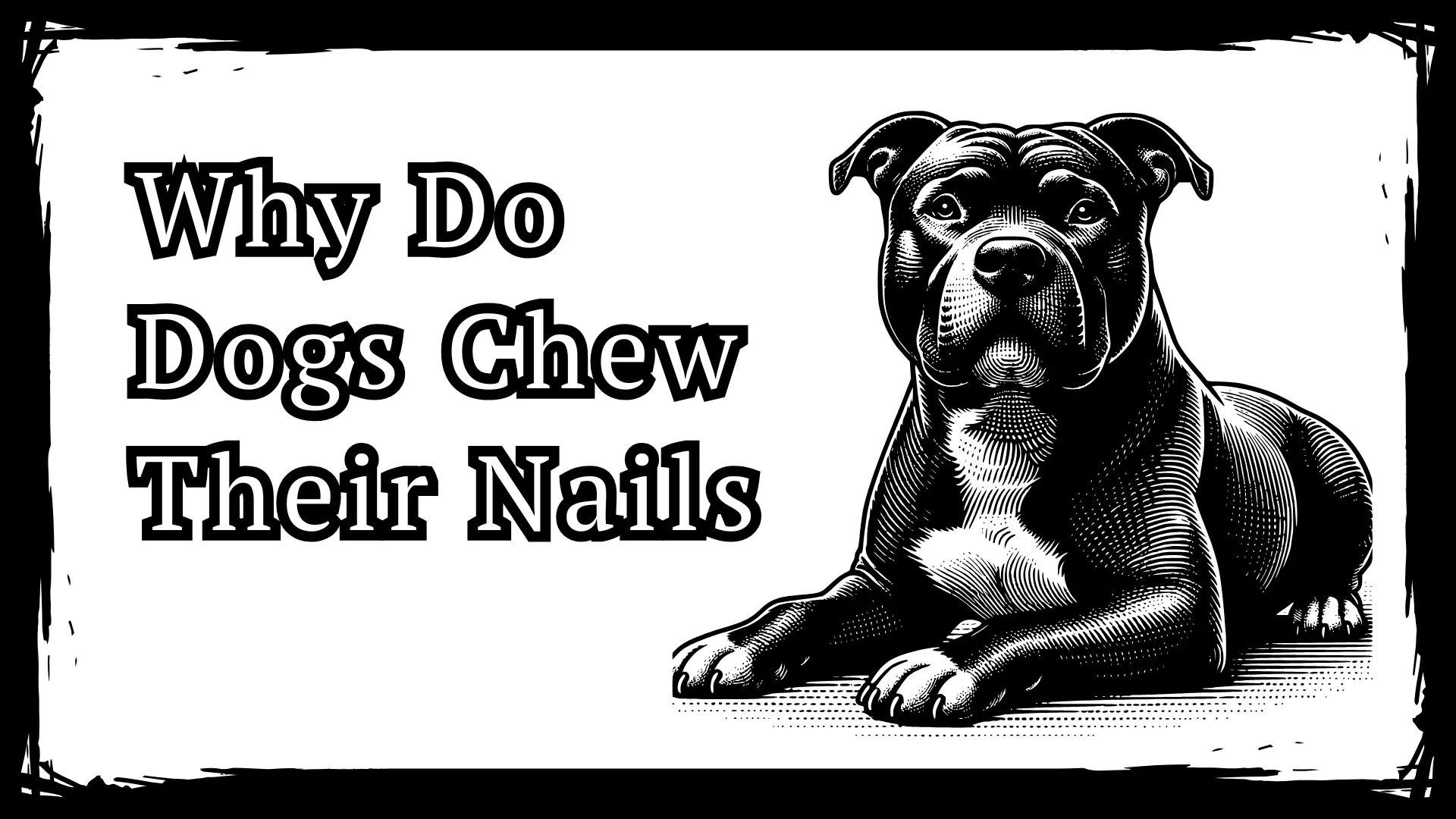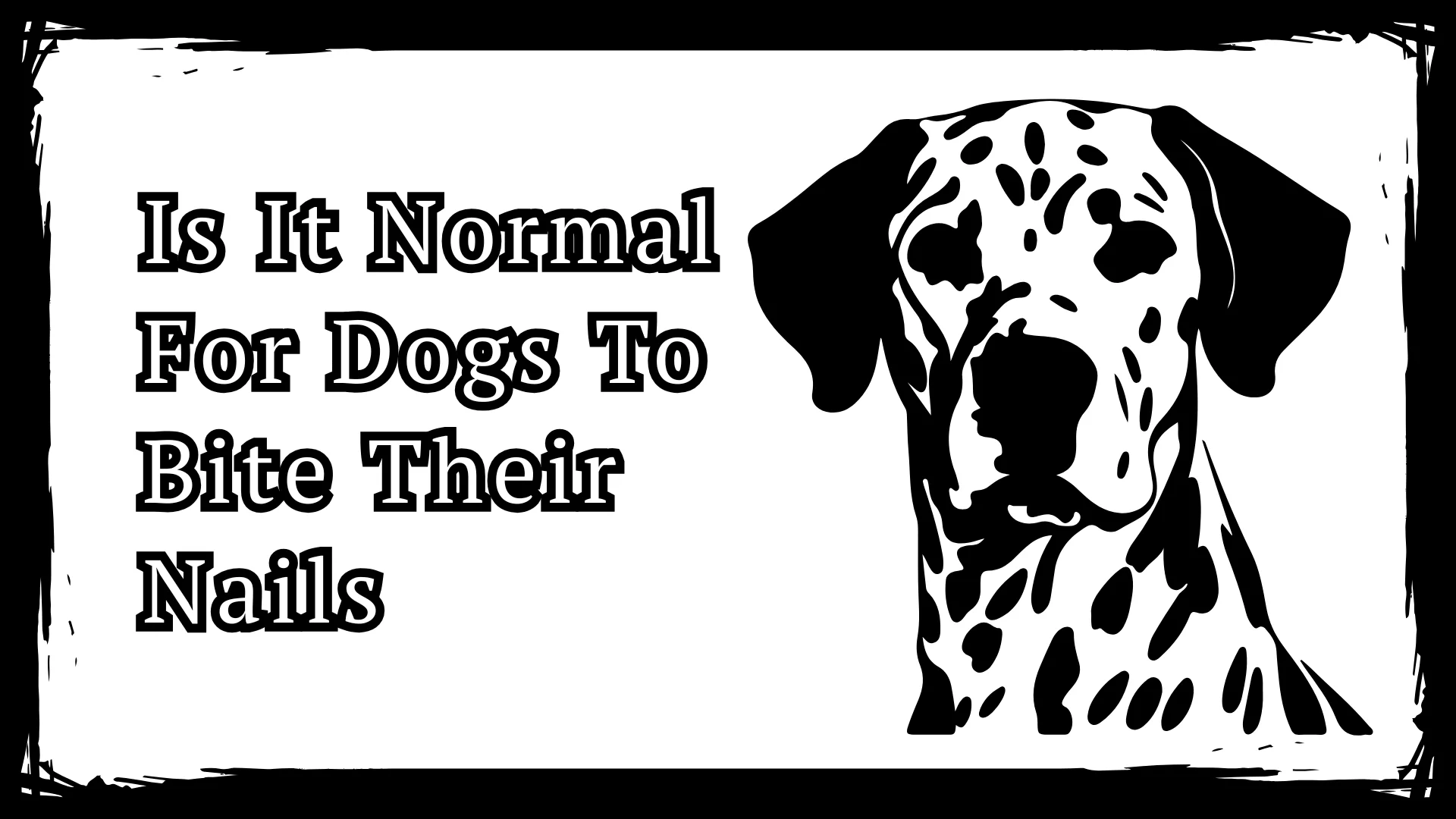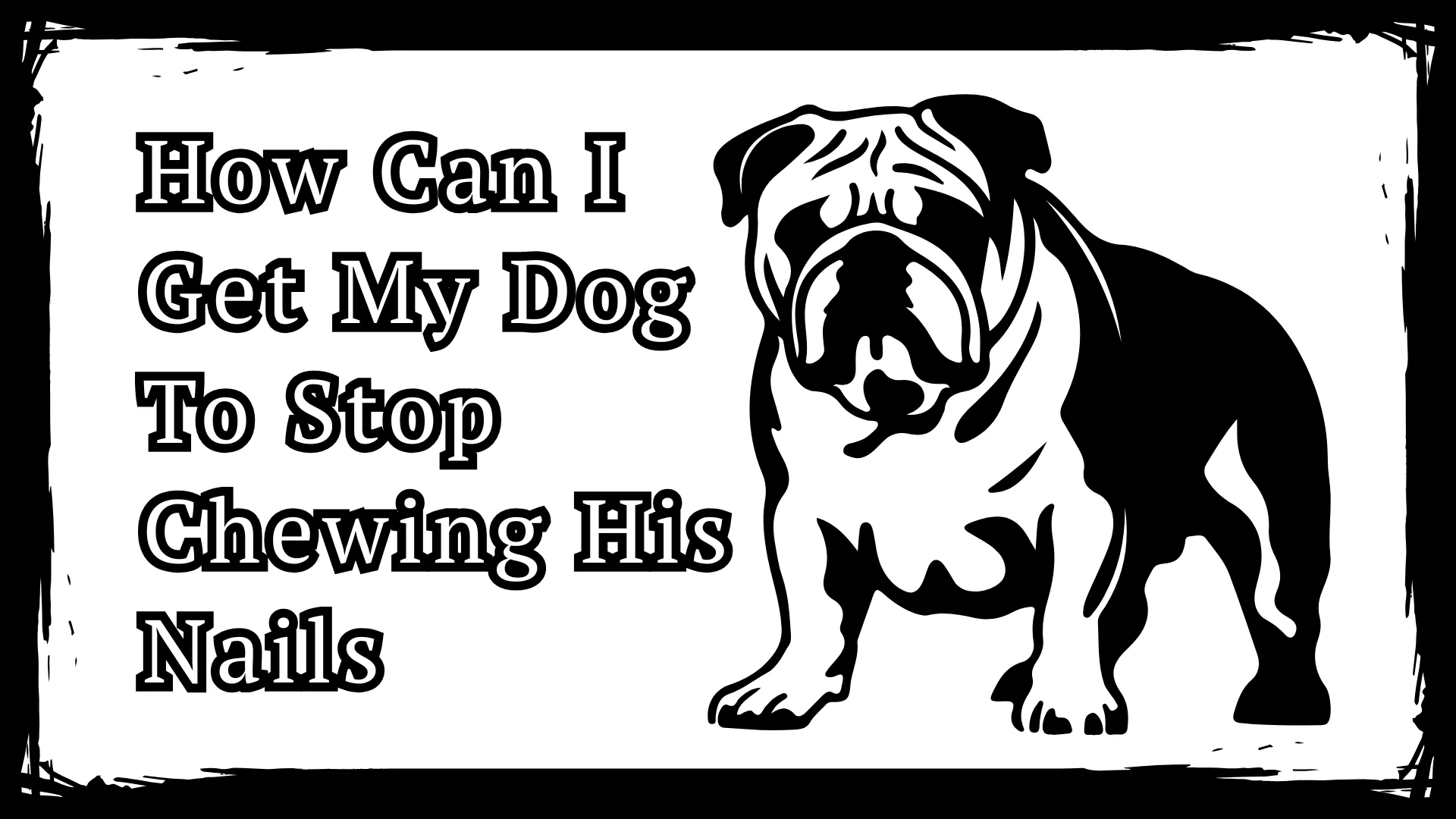Why Do Dogs Chew Their Nails – 23 Warning Signs to Know

Why do dogs chew their nails? This common behaviour often leaves dog owners puzzled or concerned. While occasional nail chewing can be normal grooming, frequent or aggressive biting may point to discomfort, stress, allergies, or even underlying health issues.
Dogs chew their nails due to allergies, anxiety, boredom, or infections. Overgrown, broken, or ingrown nails can also cause discomfort. Regular grooming helps prevent it.
In this guide, we’ll explore the many causes of nail chewing, what signs to watch for, and how to stop the behaviour for good.
Table of Contents
ToggleWhy Do Dogs Chew Their Nails And Lick Their Paws?
Allergies
Dogs often chew their nails or lick their paws due to allergies from food, pollen, or dust. These cause itching, red skin, and constant discomfort.
Anxiety
Stress or separation anxiety may cause dogs to bite their nails or lick their paws as a calming habit. It’s often a self-soothing behaviour in nervous pups.
Boredom
When dogs feel bored or unstimulated, they might chew their nails or paws for entertainment. Mental and physical activity can reduce this unwanted behaviour quickly.
Infection

Bacterial or fungal infections cause itchiness, swelling, or discharge around the nails. Dogs chew the area to find relief from pain or irritation.
Parasitism
Parasites like fleas, ticks, or mites irritate paws and toes, making dogs chew and lick their nails to get rid of the crawling discomfort.
Injuries
A tiny cut, splinter, or nail damage can trigger chewing. Dogs instinctively lick or bite injured areas to ease pain and help healing.
Overgrown Nails
Long nails may press into paw pads, crack, or break, causing discomfort. Dogs may chew them to trim or relieve pressure while walking or running.
Ingrown Nails
Ingrown nails curl into the skin, causing pain and inflammation. A dog may chew aggressively at the nail to relieve the painful pressure.
Paw Infections
Infections in paw pads or between toes can itch or burn. Dogs respond by licking and biting their paws to soothe the irritation.
Medical Conditions
Underlying issues like hypothyroidism or autoimmune disorders may cause itchy paws or nail changes, leading dogs to chew or lick excessively for comfort.
Paw Pad Disorders
Conditions like hyperkeratosis or inflammation may affect paw pads, making them dry or painful. Dogs chew and lick to ease the discomfort.
Broken Nails
A split or cracked nail is painful and bothersome. Dogs often bite the broken part to remove it or relieve the pain it causes.
Nail Or Grooming Issue
Improper nail trimming or grooming can leave sharp edges or irritate the nail bed, causing dogs to chew or lick to fix the discomfort.
Pain
Pain from joints, injuries, or nails makes dogs focus on that area. Chewing and licking become their way to relieve the soreness or discomfort.
To Clean Their Paws
Dogs naturally clean their paws by licking or lightly nibbling, especially after walks or muddy play. It’s a normal grooming habit when done occasionally.
Vaginal Yeast Infection
Female dogs may lick their paws excessively if they’re dealing with internal infections, like vaginal yeast, which causes discomfort and odd licking habits.
Arthritis
Arthritis causes joint pain, especially in older dogs. They may chew their paws or nails near affected joints to ease the soreness or stiffness.
Behavior
Repetitive licking or chewing may be behavioural. Some dogs develop this habit when stressed, under-stimulated, or after being rewarded for it unintentionally.
Claw Diseases
Nail disorders like onychodystrophy can change nail texture or growth, making them brittle, painful, or misshapen. Dogs chew to manage the discomfort.
Dry Skin
Cold weather or poor nutrition may cause dry, flaky skin on paws. Dogs will lick or bite at them for relief from itchiness or irritation.
Environmental Allergies
Grass, dust mites, or mould can trigger allergic reactions. Dogs chew nails or lick paws to cope with the constant itch caused by these allergens.
Fleas
Flea bites are incredibly itchy, especially around the toes. Dogs chew their nails or paws to find relief from the crawling and biting sensations.
Foreign Bodies
Small objects like grass seeds, splinters, or pebbles can lodge in a dog’s paw. They chew or lick to remove the irritating item.
Fungal Infection
Fungal infections often cause one or two rough, thickened nails. The infected area becomes itchy or painful, prompting dogs to chew for relief.
Is It Normal For a Dog To Chew Their Nails?
Yes, occasionally, nail chewing is normal for dogs, just like grooming. But frequent or aggressive chewing may signal health issues like allergies, boredom, injury, or anxiety. If the habit becomes excessive, it’s best to observe the behaviour closely and consult a vet to rule out underlying causes.
How Do I Get My Dog To Stop Chewing Their Nails?
Identify The Cause
To stop nail chewing, check for allergies, anxiety, or injury. Observe behaviour closely and consult a vet to find the true reason behind the habit.
Provide Distraction
Dogs chew less when they’re busy. Offer toys, daily playtime, or chew treats to keep them mentally active and away from licking or biting nails.
Trim Nails Regularly
Long nails cause pain and chewing. Regular trimming prevents discomfort, broken nails, and infections. Use pet clippers or ask a groomer for help.
Use Anti-Chew Sprays
Bitter sprays taste bad and stop chewing. Safe for dogs, these sprays work best with training and help reduce paw licking and nail biting fast.
Train And Reward
Teach your dog to stop chewing using treats and praise. Redirect behaviour, reward calm actions, and stay consistent to build positive habits over time.
Anxiety Relief
Dogs chew their nails from stress. Use calming collars, relaxing music, or puzzle toys. If anxiety is serious, talk to a vet for safe treatment options.
When to Worry About Nail Chewing in Dogs
If a dog chews nails constantly, causes bleeding, or shows pain, it’s time to worry. This could signal infection, allergies, anxiety, or injury. When chewing becomes excessive or affects daily behaviour, a vet check is recommended to find and treat the root cause before it worsens.
You can also check our free Dog Quality of Life Calculator
Dog Biting And Pulling Nails
When dogs bite and pull their nails, it could mean they feel discomfort from overgrown nails, fungal infections, or anxiety. Constant pulling can cause bleeding or cracked nails. A vet visit helps determine whether it’s a behavioural habit or a medical issue needing proper treatment or grooming care.
Do Dogs Bite Their Nails To Trim Them
Some dogs chew their nails to shorten them, especially if they’re too long or uncomfortable. This is natural grooming behaviour, but may lead to problems if done too often. Regular nail trims prevent this need and protect dogs from painful breaks, torn nails, or accidental infections.
Dog Biting Nails And Licking Paws
Nail biting with paw licking often points to allergies, yeast infections, or skin irritation. It may also be caused by boredom or stress. If the behaviour becomes frequent or causes raw spots, it’s best to consult a vet to rule out underlying health issues and start proper care.
Also Read: Why Does My Dog Bite His Nails
Dog Bites Nails At Night
If a dog bites nails mostly at night, stress or anxiety might be the reason. Nighttime is quiet, and dogs notice discomfort more. Allergies, itchy paws, or nervous habits can also play a role. Creating a calming bedtime routine and checking for health issues can help reduce this behaviour.
Can Dogs Bite Their Nails Off
Yes, dogs can bite their nails off, especially when they’re overgrown, cracked, or painful. This can lead to bleeding, infection, or discomfort. If a dog chews nails until they break, it’s time for a proper nail trim and possibly a vet visit to check for pain or injury.
Dog Biting Nails Allergies
Dogs with allergies often chew their nails to relieve itchiness. Common triggers include food allergies, pollen, dust mites, or grass. Nail biting may also come with paw licking and redness. Identifying and avoiding the allergen—and possibly using vet-approved treatments—can stop the discomfort and chewing behaviour.
Dog Biting Nails After Grooming
Some dogs bite their nails after grooming due to irritation, sharp edges, or stress from the experience. Nail clipping can sometimes leave small splinters or sensitivity. Using a nail file to smooth edges and making grooming a calm experience can help reduce this chewing behaviour.
Why Do Dogs Chew Their Paws
Dogs chew their paws for many reasons, including allergies, fungal infections, wounds, or anxiety. It’s also a cleaning habit for some. If chewing is frequent or causes sores, it’s best to check for signs of irritation or consult a vet for diagnosis and proper care.
Why Do Dogs Chew Their Tails
Fleas, skin infections, anal gland issues, or boredom can cause tail chewing. It may also stem from anxiety or a lack of mental stimulation. If tail biting continues or causes wounds, it’s important to visit a vet and consider both medical and behavioural treatments.
Why Do Dogs Chew Their Nails At Night
Dogs may chew nails at night due to quiet surroundings, anxiety, or unnoticed daytime discomfort. Nighttime calm makes itching or irritation more noticeable. Regular nail care, a relaxing bedtime routine, and checking for infections or allergies can help reduce nighttime nail chewing habits.
FAQs
How Do I Get My Dog To Stop Biting His Nails?
To stop nail biting, find the cause, like allergies, boredom, or anxiety. Offer chew toys, trim nails regularly, and use calming sprays or gentle training.
Is It Normal For My Dog To Bite Its Nails?
Occasional nail biting is normal grooming. But if it’s frequent, it might mean allergies, stress, overgrown nails, or infections. Watch behaviour and consult a vet.
How Do I Calm My Dog Down So I Can Cut His Nails?
Use gentle words, soft petting, and calming treats. Play relaxing music, take breaks, and reward calm behaviour. A peaceful setup helps reduce nail-trim anxiety.
How To Cut Dog’s Nails If They Won’t Let You?
Try short sessions with treats and praise. Use a quiet nail grinder or seek help from a groomer or vet. Patience and practice make it easier.
What Are The Best Calming Treats For Dogs?
The best calming treats often contain chamomile, L-theanine, or melatonin. These natural ingredients help reduce anxiety and make grooming or nail trimming less stressful.
Can I Give My Dog Benadryl To Calm Him Down To Cut His Nails?
Yes, with a vet’s advice. Benadryl may calm dogs during grooming. Always ask a vet for a safe dosage and confirm it’s okay for your dog.
What Can I Give My Dog To Let Me Cut His Nails?
Use calming chews, natural supplements, or anxiety wraps. Peanut butter or treat distractions help. Always pair rewards with gentle handling for a stress-free trim.
How Do Vets Cut Aggressive Dogs’ Nails?
Vets use muzzles, calming techniques, and trained staff. Some dogs may need mild sedation. Vets ensure safety while trimming nails, even for fearful or aggressive pets.
Do Vets Sedate Dogs To Cut Nails?
Yes, vets sometimes sedate anxious or aggressive dogs for nail trims. It’s usually safe, controlled, and used when all other calming methods don’t work.
What Is a Natural Sedative For Dogs To Cut Nails?
Chamomile, valerian root, and CBD oil are gentle natural sedatives. They help calm nervous dogs before nail trims. Always check with a vet before use.
Conclusion
Dogs chew their nails for many reasons, ranging from allergies and stress to infections or boredom. While occasional chewing is normal, frequent or aggressive nail biting may point to deeper health or behavioural concerns. Regular grooming, mental stimulation, and vet checks can prevent most issues. Always observe changes and act early for a happier, healthier pup.
You may also like

Latest Posts
- What Does It Mean When A Dog Throws Up Yellow – 9 Key Reason
- Can Fleas Cause Seizures in Dogs? 3 Shocking Truth Revealed
- How Do You Know If Your Dog Has Parvo? 5 Early Warning Signs
- How to Know if Your Dog Has Parvo? Know Early Signs of Parvo
- Should I Put My Dog Down If He Is Still Eating – 17 Signs
| M | T | W | T | F | S | S |
|---|---|---|---|---|---|---|
| 1 | 2 | 3 | 4 | 5 | 6 | 7 |
| 8 | 9 | 10 | 11 | 12 | 13 | 14 |
| 15 | 16 | 17 | 18 | 19 | 20 | 21 |
| 22 | 23 | 24 | 25 | 26 | 27 | 28 |
| 29 | 30 | |||||




Leave a Reply